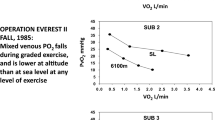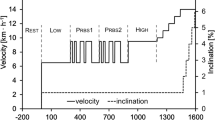Abstract
Purpose
The aim of the study was to test whether or not the arteriovenous oxygen concentration difference (avDO2) kinetics at the pulmonary (avDO2pulm) and muscle (avDO2musc) levels is significantly different during dynamic exercise.
Methods
A re-analysis involving six publications dealing with kinetic analysis was utilized with an overall sample size of 69 participants. All studies comprised an identical pseudorandom binary sequence work rate (WR) protocol—WR changes between 30 and 80 W—to analyze the kinetic responses of pulmonary (\(\dot {V}{{\text{O}}_2}{\text{pulm}}\)) and muscle (\(\dot {V}{{\text{O}}_2}{\text{musc}}\)) oxygen uptake kinetics as well as those of avDO2pulm and avDO2musc.
Results
A significant difference between \(\dot {V}{{\text{O}}_2}{\text{musc}}\) (0.395 ± 0.079) and \(\dot {V}{{\text{O}}_2}{\text{pulm}}\) kinetics (0.330 ± 0.078) was observed (p < 0.001), where the variables showed a significant relationship (rSP = 0.744, p < 0.001). There were no significant differences between avDO2musc (0.446 ± 0.077) and avDO2pulm kinetics (0.451 ± 0.075), which are highly correlated (r = 0.929, p < 0.001).
Conclusion
It is suggested that neither avDO2pulm nor avDO2musc kinetic responses seem to be responsible for the differences between estimated \(\dot {V}{{\text{O}}_2}{\text{musc}}\) and measured \(\dot {V}{{\text{O}}_2}{\text{pulm}}\) kinetics. Obviously, the conflation of avDO2 and perfusion (\({\dot {Q}}\) ) at different points in time and at different physiological levels drive potential differences in \(\dot {V}{{\text{O}}_2}{\text{pulm}}\) and \(\dot {V}{{\text{O}}_2}{\text{musc}}\) kinetics. Therefore, \({\dot {Q}}\) should, in general, be considered whenever oxygen uptake kinetics are analyzed or discussed.









Similar content being viewed by others
Abbreviations
- ACF [a.u.]:
-
Auto-correlation function
- avDO2 [L L−1]:
-
Arteriovenous oxygen concentration difference
- avDO2musc [L L−1]:
-
avDO2 at exercising musculature
- avDO2pulm [L L−1]:
-
avDO2 at pulmonary level
- CCF:
-
Cross-correlation function
- CCFlag [s]:
-
Lag (x-axis value) of CCFmin or CCFmax
- CCFmax [a.u.]:
-
Maximum of cross-correlation function
- CCFmin [a.u.]:
-
Minimum of cross-correlation function
- ΔLagCCFmax(avDO2) [s]:
-
Difference between CCFlag of CCFmax between avDO2pulm and avDO2musc
- ΔLagCCFmax(\(\dot {V}{{\text{O}}_2}\)) [s]:
-
Difference between CCFlag of CCFmax between \(\dot {V}{{\text{O}}_2}{\text{pulm}}\) and \(\dot {V}{{\text{O}}_2}{\text{musc}}\)
- HR [min−1]:
-
Heart rate
- LagCCFmin(tVT) [s]:
-
Lag value of CCFmin of tVT
- ND:
-
Normal distribution
- [PCr]:
-
Intramuscular phosphocreatine concentration
- PRBS:
-
Pseudorandom binary sequence
- PRBS approach:
-
Model implying pseudorandom binary sequence work rate changes combined with time-series analysis
- \({\dot {Q}}\) [L min−1]:
-
Perfusion (cardiac output)
- \({\dot {Q}_{{\text{rem}}}}\) [mL min−1]:
-
Perfusion of non-exercising tissues
- r [a.u.]:
-
Pearson’s correlation coefficient
- r SP [a.u.]:
-
Spearman’s rank correlation coefficient
- STEP:
-
Model implying repeated step responses in work rate combined with exponential data-fitting procedures
- SVex [ml]:
-
Exercise stroke volume
- τ [s]:
-
Time constant of mono-exponential function
- t VT [s]:
-
Venous transit time
- \({\bar{t}}_{\text{VT}}\) [s]:
-
Mean value of tVT during the PRBS phases (600 s)
- TD [s]:
-
Time delay of mono-exponential function
- \(\dot {V}{{\text{O}}_2}$$\) [L min−1]:
-
Oxygen uptake
- \(\dot {V}{{\text{O}}_2}{\text{musc}}\) [L min−1]:
-
Exercising muscle oxygen uptake
- \(\dot {V}{{\text{O}}_2}{\text{pulm}}\) [L min−1]:
-
Pulmonary oxygen uptake
- \(\dot {V}{{\text{O}}_2}{\text{rem}}\) [L min−1]:
-
Oxygen uptake in non-exercising tissues
- V v [mL]:
-
Venous blood volume
- WR [W]:
-
Work rate
References
Barstow TJ, Molé PA (1987) Simulation of pulmonary O2 uptake during exercise transients in humans. J Appl Physiol 63:2253–2261
Barstow TJ, Molé PA (1991) Linear and nonlinear characteristics of oxygen uptake kinetics during heavy exercise. J Appl Physiol 71:2099–2106
Barstow TJ, Lamarra N, Whipp BJ (1990) Modulation of muscle and pulmonary O2 uptakes by circulatory dynamics during exercise. J Appl Physiol 68:979–989
Barstow TJ, Buchthal S, Zanconato S, Cooper DM (1994) Muscle energetics and pulmonary oxygen uptake kinetics during moderate exercise. J Appl Physiol 77:1742–1749
Bearden SE, Moffatt RJ (2001) V′O2 and heart rate kinetics in cycling: transitions from an elevated baseline. J Appl Physiol 90:2081–2087
Beaver WL, Lamarra N, Wasserman K (1981) Breath-by-breath measurement of true alveolar gas exchange. J Appl Physiol 51:1662–1675
Benson AP, Grassi B, Rossiter HB (2013) A validated model of oxygen uptake and circulatory dynamic interactions at exercise onset in humans. J Appl Physiol 115:743–755
Buchheit M, Laursen PB, Ahmaidi S (2009) Effect of prior exercise on pulmonary O2 uptake and estimated muscle capillary blood flow kinetics during moderate-intensity field running in men. J Appl Physiol 107:460–470
Cautero M, Di Prampero PE, Capelli C (2003) New acquisitions in the assessment of breath-by-breath alveolar gas transfer in humans. Eur J Appl Physiol 90:231–241
Cochrane JE, Hughson RL (1992) Computer simulation of O2 transport and utilization mechanisms at the onset of exercise. J Appl Physiol 73:2382–2388
Drescher U, Koschate J, Hoffmann U (2015) Oxygen uptake and heart rate kinetics during dynamic upper and lower body exercise: an investigation by time-series analysis. Eur J Appl Physiol 115:1665–1672
Drescher U, Koschate J, Schiffer T, Hoffmann U (2016) Analysis of cardio-pulmonary and respiratory kinetics in different body positions: impact of venous return on pulmonary measurements. Eur J Appl Physiol 116:1343–1353
Drescher U, Koschate J, Hoffmann U, Schneider S, Werner A (2017a) Effect of acute ambient temperature exposure on cardio-pulmonary and respiratory kinetics in men. Int J Hyperth 34(4):442–454. https://doi.org/10.1080/02656736.2017.1354402
Drescher U, Koschate J, Schiffer T, Schneider S, Hoffmann U (2017b) Analysis of heart rate and oxygen uptake kinetics studied by two different pseudo-random binary sequence work rate amplitudes. Respir Physiol Neurobiol 240:70–80
Drescher U, Schmale R, Koschate J, Thieschäfer L, Schiffer T, Schneider S, Hoffmann U (2018a) Non-invasive estimation of muscle oxygen uptake kinetics with pseudorandom binary sequence and step exercise responses. Eur J Appl Physiol 118(2):429–438
Drescher U, Schefter T, Koschate J, Schiffer T, Brixius K, Schneider S, Hoffmann U (2018b) Oxygen uptake kinetics following six weeks of interval and continuous endurance exercise training—an explorative pilot study. Respir Physiol Neurobiol 247:156–166
Eßfeld D, Hoffmann U, Stegemann J (1991) A model for studying the distortion of muscle oxygen uptake patterns by circulation parameters. Eur J Appl Physiol 62:83–90
Fick A (1870) Ueber die Messung des Blutquantums in den Herzventrikeln. Sitz der Physik-Med Ges Wurzburg 2:16
Fortin J, Habenbacher W, Heller A, Hacker A, Grüllenberger R, Innerhofer J, Passatzh H, Wagner C, Haitchi G, Flotzinger D, Pacher R, Wach P (2006) Non-invasive beat-to-beat cardiac output monitoring by an improved method of transthoracic bioimpedance measurement. Comput Biol Med 36:1185–1203
Geigy Scientific Tables (1990) Heart and circulation. Basel, Switzerland
Grassi B, Poole DC, Richardson RS, Knight DR, Erickson BK, Wagner PD (1996) Muscle O2 uptake kinetics in humans: implications for metabolic control. J Appl Physiol 80:988–998
Grassi B, Pogliaghi S, Rampichini S, Quaresima V, Ferrari M, Marconi C, Cerretelli P (2003) Muscle oxygenation and pulmonary gas exchange kinetics during cycling on-transitions in humans. J Appl Physiol 95:149–158
Hoffmann U, Drescher U, Benson AP, Rossiter HB, Eßfeld D (2013) Skeletal muscle VO2 kinetics from cardio-pulmonary measurements: assessing distortions through O2 transport by means of stochastic work-rate signals and circulatory modelling. Eur J Appl Physiol 113:1745–1754
Jones AM, Poole DC (2013) Oxygen uptake kinetics in sport, exercise and medicine. Routledge, Abingdon
Koga S, Poole DC, Shiojiri T, Kondo N, Fukuba Y, Miura A, Barstow TJ (2005) Comparison of oxygen uptake kinetics during knee extension and cycle exercise. Am J Physiol Regul Integr Comp Physiol 288:R212–R220
Krustrup P, Jones AM, Wilkerson DP, Calbet JA, Bangsbo J (2009) Muscular and pulmonary O2 uptake kinetics during moderate- and high-intensity sub-maximal knee-extensor exercise in humans. J Physiol 587:1843–1856
Lador F, Kenfack MA, Moia C, Cautero M, Morel DR, Capelli C, Feretti G (2006) Simultaneous determination of the kinetics of cardiac output, systemic O2 delivery, and lung O2 uptake at exercise onset in men. Am J Physiol Regul Integr Comp Physiol 290:R1071–R1079
Lai N, Camesasca M, Saidel G, Dash RK, Cabrera ME (2007) Linking pulmonary oxygen uptake, muscle oxygen utilization and cellular metabolism during exercise. Ann Biomed Eng 35:956–969
Mezzani A, Grassi B, Giordano A, Corrà U, Colombo S, Giannuzzi P (2010) Age-related prolongation of phase I of VO2 on-kinetics in healthy humans. Am J Physiol Regul Integr Comp Physiol 299:R968–R976
Murias JM, Kowalchuk JM, Paterson DH (2010) Speeding of V′O2 kinetics with endurance training in old and young men is associated with improved matching of local O2 delivery to muscle O2 utilization. J Appl Physiol 108:913–922
Murias JM, Spencer MD, Kowalchuk JM, Paterson DH (2011) Influence of phase I duration on phase II VO2 kinetics parameter estimates in older and young adults. Am J Physiol Regul Integr Comp Physiol 301:R218–R224
Rossiter HB, Ward SA, Kowalchuk JM, Howe FA, Griffiths JR, Whipp BJ (2002) Dynamic asymmetry of phosphocreatine concentration and O2 uptake between the on- and off- transients of moderate- and high-intensity exercise in humans. J Physiol 541:991–1002
Rühle K, Fischer J, Matthys H (1983) Norm values in spiroergometry. Atemwegs- Lungenkrankheiten 9:157–173
Whipp BJ, Ward SA, Lamarra N, Davies JA, Wasserman K (1982) Parameters of ventilatory and gas exchange dynamics during exercise. J Appl Physiol 52:1506–1513
Whipp BJ, Higgenbotham MB, Cobb FC (1996) Estimating exercise stroke volume from asymptotic oxygen pulse in humans. J Appl Physiol 81:2674–2679
Author information
Authors and Affiliations
Contributions
UH, SS, and UD contributed conception and design of the study. UD wrote the manuscript. JK, LT, and UD analyzed the data. All authors contributed to manuscript revision, read, and approved the submitted version.
Corresponding author
Ethics declarations
Conflict of interest
The authors declare that they have no conflict of interest.
Additional information
Communicated by Guido Ferretti.
Rights and permissions
About this article
Cite this article
Drescher, U., Koschate, J., Thieschäfer, L. et al. Temporal dissociation between muscle and pulmonary oxygen uptake kinetics: influences of perfusion dynamics and arteriovenous oxygen concentration differences in muscles and lungs. Eur J Appl Physiol 118, 1845–1856 (2018). https://doi.org/10.1007/s00421-018-3916-x
Received:
Accepted:
Published:
Issue Date:
DOI: https://doi.org/10.1007/s00421-018-3916-x




